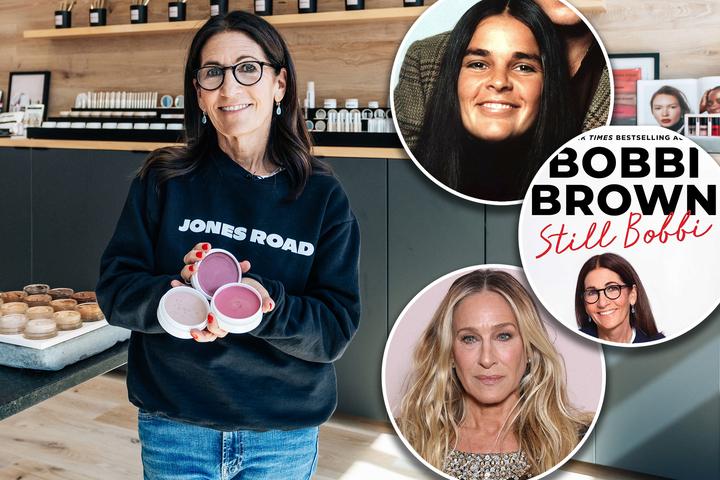The Journey of Bobbi Brown: Championing Natural Beauty in a Changing World
In 1980, makeup artist Bobbi Brown had what seemed like a simple yet revolutionary thought: “real faces are beautiful.” This philosophy became the cornerstone of her career and personal ethos, though the definition of “real faces” has transformed dramatically over the decades. While Brown’s original vision celebrated freckles, gap teeth, and natural features, today’s beauty standards have shifted toward a world where cosmetic procedures are not only accepted but expected. “In the ’80s, real faces meant people without nose jobs, people who let their freckles show, people with gaps in their teeth,” reflects Brown, now 68. “It’s definitely evolved into something different.” The normalization of procedures that were once taboo has created a beauty landscape where young women seek preventative Botox before wrinkles appear and where distinctive features are often altered to match a uniform aesthetic ideal.
Despite this cultural shift, Brown remains diplomatically steadfast in her appreciation for natural beauty. While acknowledging that some women have undergone subtle, virtually undetectable cosmetic work, she expresses concern about excessive procedures, particularly when young women in their twenties feel pressure to alter their appearance. “Who says you can’t be attractive with small lips? Who says you can’t be attractive in a natural way?” she questions. This perspective has been Brown’s enduring message throughout her remarkable career, which began in the glamorous 1980s when she worked with supermodels like Cindy Crawford and Linda Evangelista. In 1991, she launched her eponymous brand based on just ten shades of lipstick—a venture so successful that Estée Lauder acquired it four years later, transforming it into a billion-dollar enterprise. The deal included a 25-year non-compete clause preventing Brown from using her name on another beauty line for a quarter century.
Brown’s professional journey defied her own expectations. When signing the Lauder deal at 37, she naively imagined her career would end by age 60—”Time to retire! Pour me a tequila shot,” she recalls thinking. Instead, when she departed Estée Lauder in 2016, it marked a fresh beginning. Her clean beauty brand, Jones Road, launched on October 26, 2020—the very day her non-compete agreement expired. This entrepreneurial spirit runs in Brown’s family; she grew up in Wilmette, a Chicago suburb, with a grandfather who owned a Cadillac dealership and a father who pursued various business ventures. Her upbringing provided her with contrasting female influences: her mother Sandra, who embraced beauty treatments and fad diets, and her Aunt Alice, who prioritized comfort over fussiness. “My house was the perfect shoes. Her house was fuzzy slippers,” Brown writes. These dual influences—practical comfort alongside thoughtful beauty—shaped the philosophy that would guide her career, even as she navigated her mother’s bipolar disorder and periodic hospitalizations during her childhood.
Brown’s genuine enthusiasm for natural beauty has resonated with many, including the author, who recounts a meaningful encounter with Brown during a Mother’s Day makeover event at Barney’s. As a young woman with a prominent birthmark covering half her face, the author appreciated Brown’s excitement and support when she expressed her desire not to cover the birthmark but to work with it. Brown’s positive reaction—praising the author’s mother for instilling such confidence—exemplifies her authentic appreciation for distinctive features. Interestingly, Brown herself faced suggestions to alter her appearance as a teenager when her mother proposed a nose job, a common procedure for suburban girls in the 1960s and 70s. Brown never felt bothered by her nose, and she understood her mother’s suggestion came from a place of love. Despite initially wishing she could be “thin and blonde” as a teen, Brown experienced a breakthrough moment when she saw Ali MacGraw in “Love Story” and recognized beauty in brunettes who resembled her.
Today, Brown admires celebrities like Sarah Jessica Parker who remain committed to aging naturally. “I really admire her because she has not done anything, and I think it’s incredible. She still has the same face,” Brown says. This doesn’t mean Brown hasn’t experimented herself—she tried Botox twice at age 40, but after experiencing an eye droop that alarmed her husband and then a cartoonishly arched brow, she concluded “this is the universe telling me this is not for me.” She does, however, acknowledge using non-invasive ultrasound treatments like Sofwave to tighten her jaw and neck, though she’s candid about both the pain and expense involved. Perhaps most importantly, Brown credits her husband of nearly forty years, real estate developer Steven Plofker, as her ultimate beauty secret. His preference for her natural aging process has reinforced her confidence in her own skin. Through her personal choices and professional work, Brown continues to champion the radical notion that distinctiveness—not conformity—is what makes faces truly beautiful, reminding us that in a world of increasingly homogenized beauty standards, embracing our natural features might be the most revolutionary act of all.















